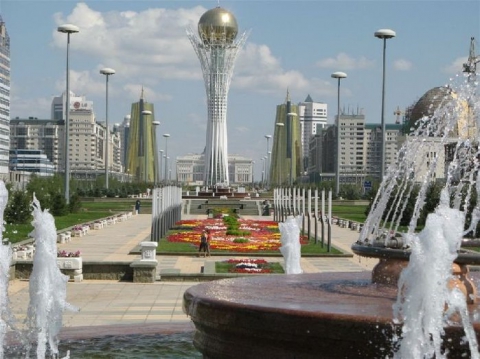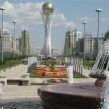
Doing Business in Kazakhstan: Two Thumbs Up from the IFIs
Publication: Eurasia Daily Monitor Volume: 9 Issue: 205
By:

The latest World Bank (WB)/International Finance Corporation (IFC) Doing Business 2013 (DB) report reveals remarkable progress achieved by Kazakhstan in creating a business-friendly environment: it ranks 49th out of 185 countries surveyed. Especially impressive is the country’s improvement in one of the key indicators—ease of starting a business—where Kazakhstan moved from 55th place to 25th in one year. To compare, Russia is ranked 112th, while the closest Central Asian country on the list, Kyrgyzstan, is in 70th place (www.doingbusiness.org).
The findings of the DB report are supported by other studies such as, for example, the 2012–2013 Global Competitiveness Report (GCR) by the World Economic Forum, which puts the country in 51st place in the overall rating (www.weforum.org). To compare, Russia is ranked 67th. Remarkably, Kazakhstan is ranked 16th in the world in the all-important category of macroeconomic stability, an indication that despite the adverse impact of the 2007–2009 global financial and economic crisis, Kazakhstan managed to recover quickly and expand economic activity.
The findings of these reports attest to the substantial advancement made by Kazakhstan in creating a business- and investor-friendly environment, needed to implement Astana’s major developmental objective—the diversification of the economy by creating non-oil sectors to move away from its dependence on extractive industries. Kazakhstan’s government understands that the development of new economic sectors cannot be achieved without attracting foreign investment. Since independence, the country has been successful in attracting more than $122 billion in foreign direct investment (FDI). Yet, these investments went primarily to the oil sector. Today, the task is to bring foreign investment and expertise into the emerging sectors. To achieve that goal, Kazakhstan has made significant strides in creating a favorable legal and operational environment for domestic and foreign investors. As a result, it is ranked 10th in the world in “protecting investors” and 28th in enforcing contracts in the DB report. It is also showing steady improvement in providing access to credit for domestic businesses that allowed the Central Asian republic to move from 97th place last year to the current 83rd place.
That improvement in the business and investor climate is not just a function of number crunching. Rather, it is supported by a survey of investors’ attitudes to doing business in Kazakhstan. One such survey, the 2012 “Kazakhstan: Bridging the Perception Gap Attractiveness Survey” by Ernst & Young, asked the following question: “If you had a chance to reconsider your investment, would you still decide to invest in Kazakhstan?” In answering it, 92 percent of existing investors responded positively (www.ey.com).
One of Kazakhstan’s priorities in creating new economic sectors is nuclear energy. With around 15 percent of the world’s uranium reserves, Kazakhstan is already the leading producer, accounting for 35 percent of the world’s uranium production. Astana’s objective now is to produce and export value-added products such as processed uranium and nuclear reactor fuel that would require creating the capacity for two more stages of nuclear fuel production—processing uranium oxide into uranium hexafluoride and producing fuel assemblies. By 2015, Kazakhstan plans not only to export 30 percent of the world’s uranium, but also capture 12 percent of the world’s uranium conversion market, 6 percent of enrichment, and 30 percent of the fuel fabrication market (Republic of Kazakhstan: Country Profile 2012, p. 45).
Another priority in the diversification of the country’s energy sector is the development of renewable energy resources. Kazakhstan’s climatic conditions are favorable for the development of solar and wind energy, while its agricultural sector has the potential for the production of biomass energy resources and biofuels. The country has set itself the goal of generating four percent of its electricity by 2020 from wind power. Experts estimate that the use of low quality wheat and 1.9 million tons of grain—which otherwise would be discarded—alone would allow the country to produce one billion liters of bioethanol a year (Republic of Kazakhstan: Country Profile 2012, p. 45).
The Kazakh-US Energy Partnership Commission, which held its annual meeting in Washington, DC, on October 15–16 (see EDM, November 2), discussed the ways to achieve these goals. In the Joint Statement, both sides announced their intention to establish a Nuclear Security Training Center in Kazakhstan, “cooperate to diversify energy sources, improve laws and regulations for the purpose of promoting investments, enhance nuclear security; build capacity in nuclear energy, renewable energy technology and energy efficiency,” and explore “the potential for geothermal deployment in Kazakhstan through developing a geothermal energy resource map of Kazakhstan and conducting technical and economic analyses” (https://kazakhembus.com).
Kazakhstan’s investment attractiveness has already allowed the country to develop a regional competitive advantage in renewable energy. On October 10, BISOL, a Slovenian company, signed a contract with Samruk-Energo to install a two-megawatt turnkey solar power plant in Almaty Province (https://www.bisol.com). A week earlier, the Islamic Private Sector Development Corporation, an Islamic Development Bank company, signed a memorandum of understanding (MOU) with Kazakhstan’s National Technological Development Agency to establish a Central Asian Renewable Energy Fund to jointly invest in renewable energy projects in the region (https://gazeta.kz, October 4).
The latest DB and GCR reports, business deals and agreements signed with foreign governments and companies demonstrate that Kazakhstan is successfully moving toward achieving the twin goal of economic diversification and attracting foreign investment to support it. It is also clear that more progress is needed to sustain this success.




